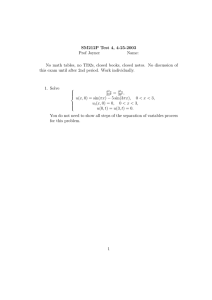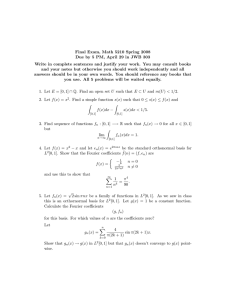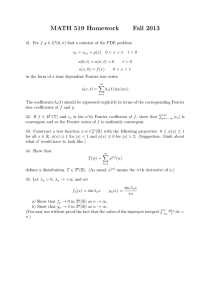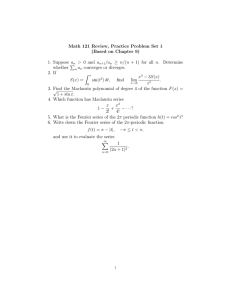Document 11271644
advertisement
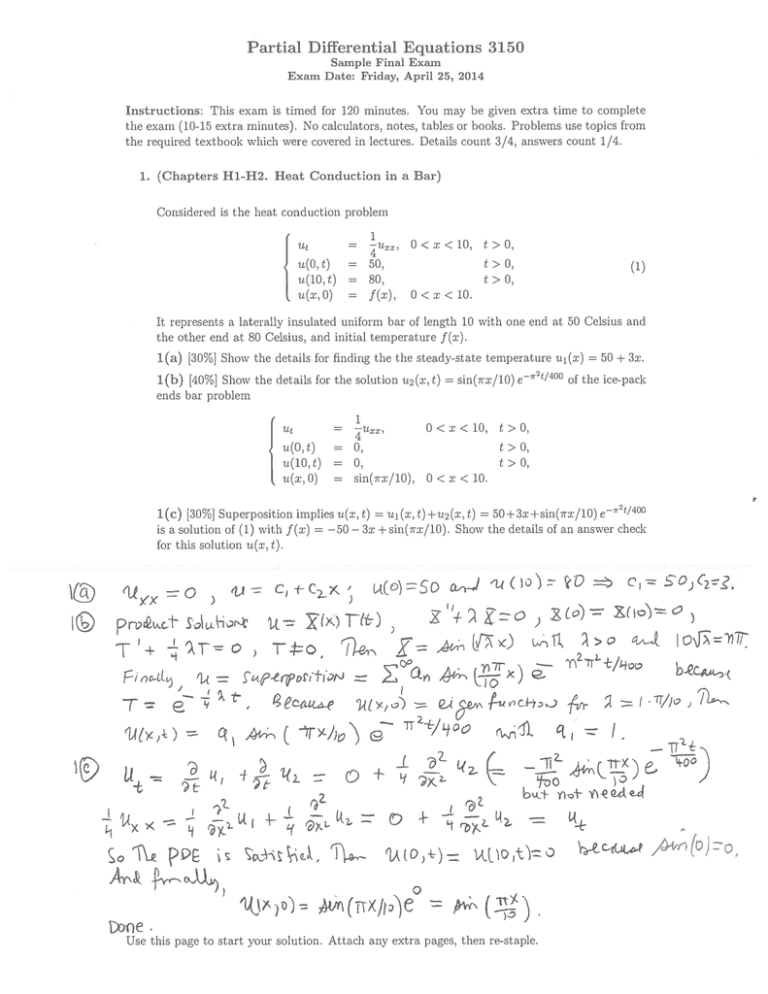
Partial Differential Equations 3150
Sample Final Exam
Exam Date: Friday, April 25, 2014
Instructions: This exam is timed for 120 minutes. You may be given extra time to complete
the exam (10-15 extra minutes). No calculators, notes, tables or books. Problems use topics from
the required textbook which were covered in lectures. Details count 3/4, answers count 1/4.
1. (Chapters H1-H2. Heat Conduction in a Bar)
Considered is the heat conduction problem
I
I
1
U1
—
u(0.t)
u(10,t)
u(x,0)
Uxx,
t>0,
t>0,
t> 0,
=
50,
80,
=
f(x),
=
0<x<10.
(1)
0<z<10.
It represents a laterally insulated uniform bar of length 10 with one end at 50 Celsius and
the other end at 80 Celsius, and initial temperature f(x).
(x)
1
1(a) [30%] Show the details for finding the the steady-state temperature u
{
1(b) [40%] Show the details for the solution u2(x, t)
ends bar problem
1
Ut
=
u(0,t)
u(10,t)
u(x, 0)
=
=
=
sin(xx/10)
0<x<10,
/4
e_
t
2
=
50 + 3x.
of the ice-pack
t>0,
t>0,
t>0,
0,
0,
sin(irx/10),
0 <x < 10.
t/4
2
1(c) [30%] Superposition implies u(x, t) = xi (x, t) +u2(x, t) = 50+3x +sin(irx/10) e_
is a solution of (1) with f(x) = —50— 3x + sin(irx/10). Show the details of an answer check
for this solution u(x. t).
j©
O)(
2
S
1
c
(o)So -J
c,c’
)
)
TO
T’+
T
e
7) Z=W)
T*:O
ec(L
m
—
(
11
io=77
I /1
—
I.
)
I
bu.i- mi- Y’1e4
1)
rcxIi)e
()
Use this page to start your solution. Attach any extra pages, then re-staple.
)
3150 Sample Final Exam S2014
Name.
2. (Chapter H3. Fourier Series)
2(a) [20%] Find and display the nonzero terms in the Fourier series expaision of f(x),
(x) + 4 cos(2x) on
2
formed as the even 2ir-periodic extension of the function fo(x) = sin
0<x < 7T.
2(b) [40%] Let g(x) be the Fourier sine series for the the period 2 odd extension of the
function go(x) = 1 on 0 <x 1. Complete the following.
(1)
(2)
(3)
(4)
(5)
Graph of g with its odd extension on x < 1.
Graph of g(x) over 4 periods.
Fourier sine series coefficient formulas.
Numerical values for the coefficients.
Gibbs overshoot graphic on x < 2.
I
sin(2x)
0
2:
and let h(s) be the 4 odd periodic
2,
extension of ho(s) to the whole real brie. Compute the sum h(—5.257r) + h(1.5ir).
2(c) [20%] Define ho(s)
=
<
—
<
2(d) [20%] Compute the smallest period, for those functions which are periodic.
(1)
(2)
(3)
(4)
fi(s)=2sin(x)+5cos(x)
(s)=sin(x)+cos(5s)
2
f
(x)=sin(x)+cos(irx)
3
f
f4(s) = sin(s) + sin(s) cos(s)
—
±
—
1
No
ic
L
o)
S
—
...
$ —
A
—
I
(
u
2
-
.-C):)
ixi 4-..Tr)
2 -c (2x)
\s
fl.e Four
zj
0
‘511
-fu-
0
iL
F0 ‘Al
i&
1;-HQc)
posc
crAA
Iqt
h
b ‘1
h
—
OchwYl
717
- ( i sir)
( ),27)
2)
)
2 11—
_
T)
o
=
A(-_-_)
=
11/ IiT, I\2i
e
Rii.c
(_2)
&
(s2+
4
k(-
( i3 )
2S1T)
7- f
)2c —) * —) o.2)1
S QWL
Use this page to start your solution. Attach any extra pages, then re-staple.
-
J2$
c
fr-
3
çR
V
0
-I
(
11
ii
cçL
r
I-
C
—)c
-4-
--
-,
—
i;
ii
.4-.-
0
‘V
(j
-L
C’
v)
0
1
(I
3150
Name.
{
3. (CR H4. Finite String: Fourier Series Solution)
3(a) [50%] Complete the following for the finite string
1
(z,t),
1
u
u(x,t)
u(0,t)
u(2.t)
=
u(x,0)
0
<
=
f(x),
=
g(r),
Final
Exam
S2014
problem
x <2,
0,
0,
=
Sample
t > 0,
t>0,
t>O,
0<x<2,
0<x<2.
(1) Separation of variables details.
(2) Product solutions and boundary conditions.
(3) The normal modes.
(4) Superposition.
(5) Series solution u(x,t).
3(b) [25%] Display explicit
the symbols f(x), g(x).
3(c) [25%]
3
Evaluate
the
formulas for
the
coefficients when
generalized Fourier coefficients
f(x)
100
and g(x) =
which
0.
4
t) T()
tt
contains
±
9
Ly
L
4
I
-1T)
J
(ii
(nX)
J2
T
(1Y
,
(
)
/
L
(2% (
/p’
2..
1
(f
Z
.)
0
3X)
b (Yr
Tr
,
ç()cclc
2
—S
0
Use
this
2-
(1)
-I
page to start your solution.
hn
-
9c2
—
WIT/2
Attach
any extra pages, then re-staple.
3150 Sample Final Exam S2014
Name.
4. (CH H4. Rectangular Membrane)
Complete the following for the general membrane problem
lJ t)
=
Qu(x.y,t)±u(x,y,t)),
2
c
u(x,y,t)
=
0
u(x,y,0)
7 0)
p
=
f(x.y).
=
g(x,y),
utt (x,
under the assumptions a
=
b
1, f(x,y)
= c =
=
1, g(z,y)
=
0.
(1) Separation of variables.
(2) Product solution boundary value problems.
(3) Product solutions (the normal modes).
(4) Superposition for n(x, y, t).
(5) Generalized Fourier coefFicient formulas.
(6) Explicit numerical values for the coefficients.
(1)
il
i(C)
(
)
cT
S
1
\ X(=
Yt )
P
/
0
1
>3
I
I
frT11)rp
—)-X
7
To
T
\
0
FeTe
=
t>0,
0<x<a, 0<y<b.
on the boundary,
0<x<a, 0<y<b,
0<x<a, 0<y<b.
(2 ?C)
()
)i
-rT)
I
Z. 4rTT)
=
)V
c)
(3)
)
(1
c
,i
GO
() AU)
()
I..
c)
Y)LlL4,O
Q
kr
s
—
(
)O
(r4
()
0
( L)_ 0
.
L
/rrkL
t
a
I
—
1
$f
L[iCvs(rnt
1TT
2.
Use this page to start your solution. Attach any extra pages, then re-staple.
)( ‘zii!)
.y1
Name.
3150 Sample Final Exam S2014
5. (CH H5. Heat Equation and Gauss’ Heat Kernel)
5(a) [10%] Define a Fourier transform pair so as to include as many definitions as possible,
in particular, Haberman’s definition.
f(x)
1 and
5(b) [20%] Assume f() = 100 on —1
Fourier transform F(u’) of f(x).
=
0 otherwise. Compute the
Graded Details: (1) Transform formula, (2) Integration details, (3) Answer.
5(c) [50%] The heat kernel g(x) and the error function erf(x) are defined by the equations
=
erf(z)
—
2
=
“
edz.
Jo/
Solve the infinite rod heat conduction problem
I
I
1
u(x,t),
u(z,t)
u(x,0)
f(x),
=
f(x)
_<X<,
(50
100
0
=
—
<x <
t>0,
,
0<x<1,
—1 <x <0,
othenvise
Graded Details: (1) Fourier Transform method, (2) Convolution, (3) Heat kernel use, (4)
Error function methods, (5) Final answer, expressed in terms of the error function.
5(d) [10%] Compute the limits at x equal to infinity and minus infinity of u(x,t).
5(e) [10%] Compute the limit u(x,0+) for each x in
FT{
(Q)L
($)
CVS
—
<x <
.
-
f
)
e
(Lfl\)
S
Ft
1
2)t
FT
±
t
F1[)]-
re
U
1&&*
U
2
(_)
b
Lr
2 (v
i
k
b t
c =u e
G) FTE3()3
(G()
—
tU
-
=,
FC)
-o) ) 0
o O)oo,7S-
-,3
—
tr5
(-V1°
-
21T
0
—
tx-
L\00e
Iv,
1
Ii
v-_
=
-
€.
*
(nl
a
.
7
,<(
±
-
0
-
(b
‘1
—
—
::d
c
—•
“____%__)
)
_ui_
-f
%
-1__•___
I7_j_
-j
o
,‘-
-—
-
(
r
rr,
N
L
—
-‘
(P
‘1
c
—
—so
W•
c4
C?
.II
(I
s.
0
I
—
c:)
—
0
T
—,
‘-fl
-I
QJ
r
Q
fl
p
K
Lj
+
v__
0
+
r
sj_J
Ur
JQ
cI,
ii
N
rf)
1
(D
II
K.
t
(0
-
--
11
1
I.)
c1-
I
-
-<
)I
c.
çjJ
U’)
N
c
‘_ff
(I
0
ri-I
L-.
